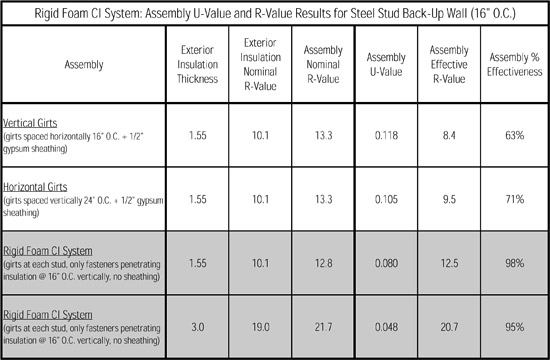Conforming to Code
Mineral fiber system. The study investigated the clear wall thermal performance for varying levels of exterior insulation of a mineral fiber system for steel stud backup walls, with and without stud cavity R-19 batt insulation. The mineral fiber system was compared with two other common cladding attachments, continuous vertical and horizontal Z-girts. It is important to note that the overall wall assemblies did not change in configuration at all, except for the cladding attachment methods.
For the vertical steel Z-girt assembly, the girts bypass the exterior insulation and are in line with the steel studs at 16 inches o.c., which creates a direct path for heat to flow past the insulation. As a result, the thermal resistance of the assembly with the vertical system is between 42 to 68 percent effective compared to the nominal resistance of the assembly. In fact, as more mineral fiber insulation is added to the assembly, the percent effective decreases. This is commonly referred to as the property of diminishing returns. Even if double the amount of insulation is added to the assembly the resulting real R-value (effective R-value) increases only fractionally. It is not a linear relationship.
Using horizontal girts spaced at 24 inches o.c., the direct heat flow from metal to metal is reduced, the overall amount of steel penetrating the insulation is reduced, and the thermal resistance values are improved compared to the vertical Z-girt assembly. However, the girts still bypass the exterior insulation, and the property of diminishing returns is still quite evident as the effectiveness of the assembly's thermal resistance is between 52 to 75 percent.
With the thermally isolated bracket mineral fiber system, the amount of material bypassing the insulation is greatly reduced by using the triangular brackets, which are also spaced off the sheathing with low conductivity, durable, plastic isolator pads at each stud, 24 inches o.c. By reducing the cross-sectional area of metal penetrating the insulation, decreasing the contact area with the ribbed plastic base, and placing low conductivity material between interconnected steel parts, the result is an effective thermal resistance between 80 and 93 percent for the assembly. Again, the property of diminishing returns is evident, but has far less impact compared to other assemblies.
The model showed that with 80-93 percent exterior insulation effectiveness, this system can meet the requirements of ASHRAE 90.1-2007/2010 in all climate zones with only 3.5 inches of exterior mineral fiber insulation without the need for interior batt insulation. Overall, the thermal performance of the modeled mineral fiber system was found to outperform the continuous vertical and horizontal girt systems.
When the thermally isolated bracket was modeled with R-19 batt insulation added to the stud cavity with exterior mineral fiber insulation, an average of R-8.3 was added to the total assembly effective R-value.
 |
Click to view large table image Courtesy of Knight Wall Systems |
Rigid foam ci system. In another study using this software the third-party testing investigated the clear wall thermal performance of a continuous insulated attachment system with isolated thermal brackets for two exterior insulation thicknesses, two fastener spacings and with and without interior sprayfoam. These configurations of the ci-system were compared with two commonly used cladding attachment systems with similar exterior and interior insulation levels. Modeling the systems without interior insulation was done to better evaluate the effectiveness of just the exterior cladding attachment arrangements
The first base assembly analyzed includes steel studs at 16 inches o.c., interior spray foam insulation (R-9.8), 1.5 inches of exterior insulation, and various attachment configurations. The continuous vertical girts penetrating the insulation were found to create a direct heat flow path to the studs, bypassing both the exterior and interior insulation. As a result, the effective assembly thermal resistance is only 50 percent of the nominal value of the assembly (resistance of the wall if there was no thermal bridging). While the continuous horizontal girt system reduces the overlap of steel parts by running perpendicular to the studs, the girts still bypass the exterior insulation. This results in a 66 percent effectiveness of the assembly thermal resistance compared to the nominal values.
 |
Click to view large table image Courtesy of Knight Wall Systems |
If the interior insulation is removed out of the assembly and only the exterior insulation is analyzed, the results change drastically. In interior insulated assemblies, steel studs produce a large amount of thermal bridging. For penetrating vertical girt systems, there is a similar amount of thermal bridging through both the exterior and interior insulations. Therefore, an exterior insulated assembly with 1.5 inches of rigid foam insulation and penetrating vertical Z-girts has a very low effective R-value. The effectiveness of the insulation for this case is only 63 percent.
Again, if the interior insulation is removed and only the exterior insulation is analyzed, but with penetrating horizontal Z-girts, the system has, overall, less thermal resistance as expected. However, the horizontal z-girt system uses the insulation slightly more effectively since the insulation is only on the exterior of the wall and the girts are spaced farther than the steel studs. With this assembly, the effectiveness of the exterior insulation is 71 percent. This is still far from the nominal, rated, R-value of the insulation.
With a rigid foam continuous insulation system, the penetrating continuous girts are replaced by stainless steel fasteners, which penetrate the exterior insulation at limited locations (8 inches o.c. vertically), reducing the amount of steel bypassing the insulation, making the system 80 percent effective. This includes the effects of thermal bridging from the steel studs through the interior spray foam, driving down the overall percent effective of the assembly as a whole.









